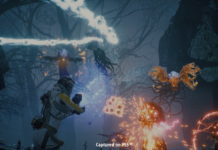It’s no surprise that most
gamers aren’t familiar with the name Matrix Software. Although their original
titles, Alundra for the PS1 and Dual Hearts on PS2, aren’t especially
well-known, each was well received critically and found small but dedicated fan
bases. Their recent work has been much higher-profile, but more
behind-the-scenes: the studio was responsible for the recent DS remakes of Final
Fantasy III and IV. After working with Square-Enix on those games for the last
few years, Matrix has once again ventured out with an original IP: Avalon Code,
an action/RPG for the DS.
Like many other RPGs, Avalon
Code puts you in control of the Chosen One—only instead of saving the world,
you’re working with its destructors. Yep, the powers that be have decided that
it’s time to scrap all existence and start fresh, and there’s nothing that can
be done to stop it. You’re given the task of deciding what parts of the current
world will be brought over to the new one, which you’ll do via the magical Book
of Prophecy. Using the book, your character can save the essence of whoever or
whatever you deem important enough to warrant saving. It’s definitely not the
kind of story you see in games every day, and while the writing can get pretty
bland sometimes, the plot hook is unique enough that it’ll hold your attention
throughout.

While you will engage in some
stereotypical RPG situations—like meeting with royalty—your character’s role in
the world’s destruction puts an interesting spin on even the most clichéd
encounter.
Avalon Code’s basic gameplay
will be familiar to action/RPG veterans. You’ll travel from towns to dungeons
and back again. Towns are full of people to interact with, shops, training
centers—your usual RPG stuff. In dungeons, you’ll be fighting against monsters,
solving puzzles, and taking on bosses—again, par for the genre course. Actually,
that’s not quite fair, as the game does offer a couple of more unique gameplay
ideas. Instead of the standard mazes, each dungeon is set up as a series of
rooms, each with its own completion requirements (like “kill all the monsters”
or “flip all the switches”) and bonus objectives (like “make it through without
taking any damage”). On the combat side, you can use the shoulder buttons to
roll in any direction, which isn’t innovative per se, but it’s certainly
appreciated when your character has only a handful of hit points (you begin with
a measly five HP). You’ve also got the Judgment Link system, which is a fancy
way of saying that, with careful timing, you can juggle enemies for massive
damage.

Combat unfolds in real time, so
evasion is just as important as attacking.
But it’s the addition of the
game’s central mechanic, the Code System, that turns the gameplay on its ear. As
I mentioned, the Book of Prophecy gives you the ability to “Scan”, that is,
capture and save the essence of any person, creature, or object in the world.
That essence is represented in the book by Codes, blocks arranged on a grid that
distill the character or object or being down to their essential elements. So a
sword’s grid might be comprised mostly of Iron codes, while a town guard might
be made up of Justice and Loyalty codes. Since you’re the chosen one, though,
you can use the book to re-arrange and adjust any given code as you see fit, and
this is where things get interesting.
Since you can manipulate the
essence of any monster, character, or object, you have the power to change the
world around you in some fundamental ways. Take combat, for instance: if you’re
having trouble against a particularly tough enemy, you might check his code
chart to find that this monster possesses the code for Stone. By simply removing
the code (or better yet, swapping it out for a code like Illness or Poison), you
can significantly weaken your opponent. Of course, a weaker enemy grants less
experience after being defeated, so you might be better off adding a Fire code
to your weapon for an elemental attack. The system’s pretty open-ended, and
you’re given the freedom to use it as you see fit.

Code Scanning requires smacking
your target upside the head with the Book of Prophecy. It’s not subtle, but it
gets the job done.
Don’t think you’ll just use the
Code System in combat, though—the mechanic works in every aspect of gameplay.
That sickly girl in town that just can’t seem to get better? She will if you
remove the Illness code that’s embedded in her essence. The rich snobby girl
might get off her high horse without that pesky Ice code, and you can save the
princess’s injured cat if you can get rid of its Wound code. By smartly using
the Code system to your advantage you’ll be able to change the world to your
liking, which can have a serious effect on the game’s storyline. The system
gives the player an incredible sense of power, which makes playing Avalon Code
unlike anything else.

Saving her beloved pet will do
wonders for your status in the eyes of the princess.
Unfortunately the Code system,
and Avalon Code in general, isn’t without its flaws. All the action unfolds on
the top screen, leaving the touchscreen free to display the Book of Prophecy.
The book acts as your all-purpose menu system, containing everything from maps
to statistics to code charts, and manipulating the book via the stylus accounts
for a huge part of the game. The problem is the book’s immense size and the lack
of any way to search its pages. You can only hold four codes at a time, and all
other codes must be stored in a character, monster, or item’s code chart. When
you desperately need to find one particular code, hidden somewhere among the
book’s hundreds of pages, the game stops dead and all fun evaporates. I also
question the developer’s decision to have code manipulation use your character’s
MP; since code manipulation is all but required to best the game’s many bosses,
good luck winning if you had to burn through your MP getting through the
dungeon. These problems don’t ruin the game, but they can lead to major
frustration, especially given how easy they would have been to fix.
Matrix got plenty of experience
working with the DS hardware during the development of the Final Fantasy
remakes, and it shows—Avalon Code is one of the best-looking 3D games on the
system. Characters and monsters look and move great, and every object has tons
of detail. The game’s camera is used intelligently—sweeping moves make event
scenes interesting and cinematic, while the more zoomed-out exploration view
shows off the scope of the vast areas you visit. The soundtrack is traditional
fantasy music, mostly orchestral stuff, but the quality is unusually high, well
above the average RPG. They’ve even packed a bunch of voice acting on the cart,
and it too is remarkably good.

The game’s 3D character models
are detailed enough that they look great, even in close-up cinematic sequences.
Avalon Code is an incredibly
ambitious and original addition to the DS’s RPG library. Sure, it’s not perfect,
but it is a unique experience that’s well worth playing. Anyone who can see past
the game’s flaws will find an engaging game like no other, one that’s both
vastly epic and intimately personal. Besides, who wouldn’t love the opportunity
to reshape the world as you see fit?
Gameplay: 7.9
While it follows many of the
standards of the action/RPG genre, the Code system keeps Avalon Code from being
anything but standard. Combat isn’t incredibly deep but it is fast-paced and
satisfying. Some pretty significant interface issues keep the game from being
all it could be, but even so the game is consistently unique and engaging.
Graphics: 8.8
Matrix Software has mastered
the 3D capabilities of the DS, and it shows: Avalon Code has some of the best
graphics available on the system. Characters, enemies, and environments are all
detailed and polished, with great animations everywhere you look.
Sound: 8.4
The game’s soundtrack is
consistently excellent, though it doesn’t stray very far from tradition—you’ll
know right away that you’re playing a fantasy RPG just from the music. Voice
work is plentiful and high-quality.
Difficulty: Medium
As you can alter your enemies’
strengths and weaknesses, combat rarely becomes too difficult, and if you die
you’re allowed to start again in the same room—no more replaying from the last
save point. Honestly, most of the game’s difficulty comes from having to deal
with the Book of Prophecy’s frustrating touch interface.
Concept: 9.0
The idea of an RPG that lets
you manipulate and change virtually anything sounds totally fun and absolutely
impossible to actually achieve. In truth, the developers pulled the whole thing
off remarkably well, considering the scope of their ambitions.
Overall: 8.0
Sure, dealing with the
interface can be irritating. That doesn’t change the fact that Avalon Code is as
unique and satisfying a game as your likely to find on the DS, or any system for
that matter. If you’re willing to put up with a little frustration to experience
one of the most original RPGs in recent memory, then Avalon Code is for you.









